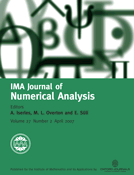-
Views
-
Cite
Cite
G. Dziuk, C. M. Elliott, Finite elements on evolving surfaces, IMA Journal of Numerical Analysis, Volume 27, Issue 2, April 2007, Pages 262–292, https://doi.org/10.1093/imanum/drl023
Close - Share Icon Share
Abstract
In this article, we define a new evolving surface finite-element method for numerically approximating partial differential equations on hypersurfaces Γ(t) in ℝn+1 which evolve with time. The key idea is based on approximating Γ(t) by an evolving interpolated polyhedral (polygonal if n = 1) surface Γh(t) consisting of a union of simplices (triangles for n = 2) whose vertices lie on Γ(t). A finite-element space of functions is then defined by taking the set of all continuous functions on Γh(t) which are linear affine on each simplex. The finite-element nodal basis functions enjoy a transport property which simplifies the computation. We formulate a conservation law for a scalar quantity on Γ(t) and, in the case of a diffusive flux, derive a transport and diffusion equation which takes into account the tangential velocity and the local stretching of the surface. Using surface gradients to define weak forms of elliptic operators naturally generates weak formulations of elliptic and parabolic equations on Γ(t). Our finite-element method is applied to the weak form of the conservation equation. The computations of the mass and element stiffness matrices are simple and straightforward. Error bounds are derived in the case of semi-discretization in space. Numerical experiments are described which indicate the order of convergence and also the power of the method. We describe how this framework may be employed in applications.





